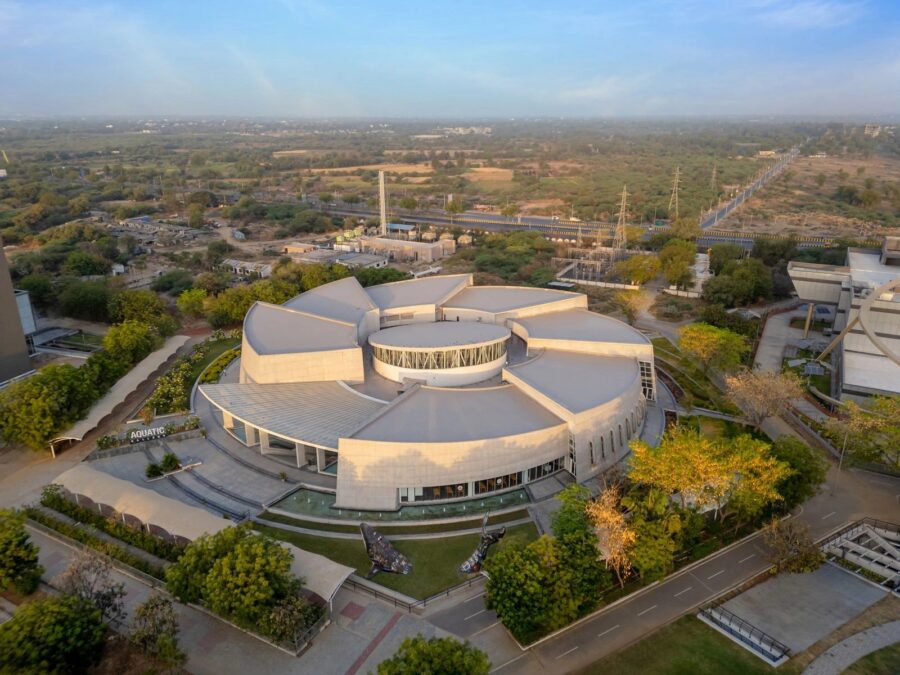私たちは建築を計画するときに、敷地・機能・予算などの与条件を絶対的なものと考えてすぐに設計に取り掛かるのではなく、「何が一番重要なのか?」「このプロジェクトでしかできないことは何か?」を再考することによって隠れたプログラム、新たなプログラムを提案したいと考えている。
今回については治療を支える病院の、建築としての役割について再考した。
一般的に連想される新建材でまとめられたハコモノ建築は、自然の色彩や素材感に乏しい空間となりがちである。特に医院建築は機能や効率を優先するあまり人工的な材料に覆われ、人としての日常感覚から遠ざかりつつある。
名古屋市北区金城町は店舗・工場・住宅が混在し、比較的建物の密度が高く、無機質な塊のような建物が多い街並みであるため、革新的で土着的な考えで建築をつくるべきだと思っていた。この考えはクライアントとも共通の想いであったため、木の温もりを感じる建物をコンセプトとすることにした。これは単に木造にしたいということではなく、機能や法規を満たし、木を感じる空間によって患者を癒す場になってほしいという願いであった。
本件の計画にあたり、今まで50件ほどクリニックを設計してきた経験をふまえて、機能や効率を満たしつつ、「地域に開かれた医院建築」とするために以下の3つのデザインストラテジーを立てた。
①街との調和と連携を図る大きな庇
木質の大きな庇は、天候に配慮された患者のアプローチ空間としてだけではなく、外にいても守られている縁側のような空間をつくり、地域コミュニティの場となる。また、大きな庇をつくることで南東面での日射遮蔽を図るパッシブデザインとする。
②地域と繋がるL字の吹き抜け空間
透明性が低いと社会に対して閉鎖的な雰囲気となる。屋内においては道路に沿ってL字の吹き抜けを計画することで、陽だまりと開放感を感じさせ視線の抜けによって、クリニック機能と社会とをシームレスにつなぐためのバッファーゾーンとして待合スペースを設けた。こうすることで社会との接点となり、地域と繋がる構えとする。
③温もりのある透明性
病院という建物こそ患者や医療従事者がストレスを感じず、より快適な環境づくりへの配慮が必要と考える。診察室などの機能性を重視した部屋には抗菌性の優れた素材と木の素材を組み合わせて使用し、患者が多く滞在する待合などには木の素材をふんだんに使い、落ち着きのある空間とし、ガラス面から木の温もりを街へと表出させる。
建物の骨格となる3つのデザインストラテジーを成立させるため、構造計画においても検討を重ねた。大きな庇と水平梁をなくした開放的なL字の吹き抜けを成立させるため、構造はブレース付き鉄骨造とした。吹抜け上部の立体トラスは重要な役割を担っている。
エントランス部が建物南東の角にあり、そこを起点に2 階がL型に吹き抜けており、開放感のある計画となっている。吹き抜けに面する2階外壁ガラス面に大胆なトラスを設け、街へのつながりを表明する効果を期待したい、という計画である。
1階大庇の元端側は開放的なL字の吹き抜けを計画するため、吹き抜け空間内に横架材を設けずに庇の垂れを防止する方法を検討した。同時にL字の吹き抜けの外壁側は先で述べたようにトラスで構成されているため鉛直材がない。そのことからエントランス吹き抜けの開放感を損なわず庇を引っ張り上げ、R階荷重を負担できるように筋かいのような圧縮ブレースを立体的に設けている。
また、露出する南東面2階ブレ-スの圧縮材はCT-150×75×7×10の2丁合わせ、引張材はFB-65×6、庇の垂れ止めの筋かいはCT-150×75×7×10の2丁合わせとした。意匠的な配慮からブレースに木部材を抱き合わせることで、利用者に木のやすらぎを感じてもらえる空間とした。
庇、吹き抜けという ありふれた建築用法を再解釈し拡張しつつ、木材という身近な素材でつくることによって、患者も医療従事者も心を落ち着かせ前向きな気持ちで過ごせる「温もりのある透明性」をもったクリニックを実現しようとした。地域医療の窓口を担う診療所こそ地域と繋がり、より快適な環境をつくりたいと考えた。(田中義彰)
A clinic where warm transparency connects people and the city
When planning a building, we do not immediately start designing by considering the conditions such as site, function, budget, etc., as absolute, but “what is the most important?” “In this project, I would like to propose a hidden program and a new program by reconsidering “What can only be done?”
This time, I reconsidered the role of the hospital that supports treatment as an architecture.
The architecture that is generally associated with new building materials tends to be a space lacking in natural colors and materials. In particular, the architecture of medical clinics has been covered with artificial materials in order to prioritize function and efficiency. It is becoming more and more distant from the ordinary senses of human beings.
In Kinjo-machi, Kita-ku, Nagoya City, there is a mix of stores, factories, and houses, and the density of buildings is relatively high.
Because the streets are full of buildings that look like inorganic masses, I thought it was time to create architecture with innovative and indigenous ideas. Since the client shared this idea, we decided to use the warmth of wood as the concept. This was not just a desire to make a wooden building, but also a wish that the building would satisfy functions and regulations and become a place to heal patients through space where they can feel the wood.
Based on our experience in designing about 50 clinics, we developed the following three design strategies to make the clinic “open to the community” while satisfying its functions and efficiency.
(1) Large eaves to harmonize and cooperate with the town
The large wooden eaves serve as a weatherproof approach space for patients and create a protected space like a veranda even when they are outside and become a place for the local community. In addition, the large eaves are designed as a passive design to shield the southeast side from the sun.
(2) L-shaped atrium space connected to the community
If the transparency is low, the building will have a closed atmosphere to the society. By planning an L-shaped atrium along the road, the waiting space is created as a buffer zone to connect the clinic’s functions with the community seamlessly. The waiting area is a buffer zone to seamlessly connect the clinic’s functions with the community, thus becoming a point of contact with society.
(3) Transparency with warmth
I believe that a hospital building should be a place where patients and medical staff feel less stress and more comfortable. So we will use a combination of antibacterial and wooden materials in the examination rooms and other functional rooms. In the waiting area where many patients stay, we will use many wooden materials to create a calm and relaxing space and let the warmth of the wood show through the glass surface to the city.
To achieve the three design strategies that form the framework of the building, I also studied the structural plan. The structure is a steel structure with braces to create an open L-shaped atrium with large eaves and no horizontal beams. In addition, the three-dimensional truss above the atrium plays an important role.
The entrance is located at the southeast corner of the building, and the second floor starts. From there, they are forming an L-shaped atrium, which gives the building a sense of openness. In addition, a bold truss is placed on the glass surface of the second-floor exterior wall facing the atrium, which is expected to have the effect of expressing the connection to the city.
To plan an open L-shaped atrium at the head end of the large eaves on the first floor, a method to prevent the eaves from sagging without installing any horizontal materials in the atrium space was considered. At the same time, the exterior wall of the L-shaped atrium is composed of trusses as described above, so there is no vertical material. Therefore, the eaves are pulled up without spoiling the sense of openness of the entrance atrium, and compression braces like reinforcing bars are installed in a three-dimensional manner to bear the load of the R-floor.
The second-floor braces on the southeast face are CT-150x75x7x10 compression braces, FB-65×6 tension braces, and CT-150x75x7x10 braces for the eaves. The braces are made of wood, which gives a sense of comfort to the users.
By reinterpreting and extending the common architectural usage of eaves and vaulted ceilings and using familiar materials such as wood, I tried to create a clinic with “warmth and transparency” where patients and medical staff can feel calm and positive. I wanted to create a more comfortable environment by connecting the clinic with the community, as it is the clinic that serves as the window for community medical care. (Yoshiaki Tanaka)
【たけなか外科内科こどもクリニック】
所在地:愛知県名古屋市北区金城町4-72
用途:医療施設
クライアント:竹中拡晴
竣工:2019年
設計:TSCアーキテクツ
担当:田中義彰
構造設計:金山美登利(モヴ構造設計)、中田琢史(リズムデザイン構造計画事務所)
空調・衛生:池田産業
電気:吉田電気工事
施工:東海インプル建設
撮影:谷川ヒロシ
工事種別:新築
構造:鉄骨造
規模:地上2階
敷地面積:711.59m²
建築面積:374.00m²
延床面積:543.37m²
設計期間:2017.10-2018.03
施工期間:2018.05-2019.01
【TAKENAKA Clinic】
Location: 4-72, Kinjo-cho, Kita-ku, Nagoya-shi, Aichi, Japan
Principal use: Medical facility
Client: Hiroharu Takenaka
Completion: 2019
Architects: TSC Architects
Design team: Yoshiaki Tanaka
Structure engineer: Midori Kanayama / Mov Structural design, Takushi Nakata / Rhythm Design
Air conditioning/hygiene: Ikeda Sangyo
Electricity: Yoshida Electric Works
Contractor: Tokai Impro Construction
Photographs: Hiroshi Tanigawa
Construction type: New Building
Main structure: Steel
Building scale: 2 stories
Site area: 711.59m²
Building area: 374.00m²
Total floor area: 543.37m²
Design term: 2017.10-2018.03
Construction term: 2018.05-2019.01








